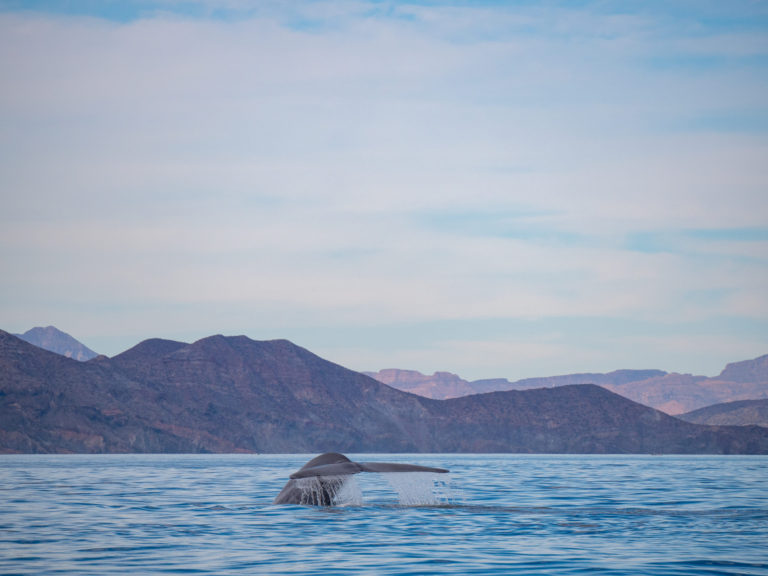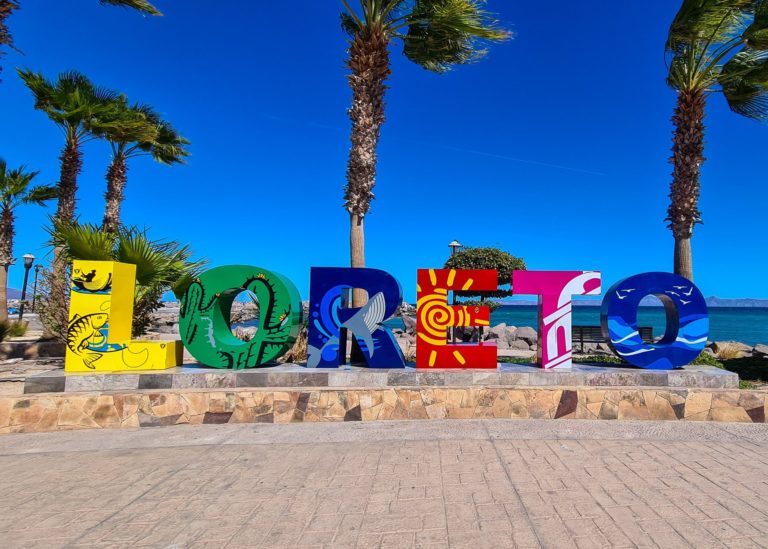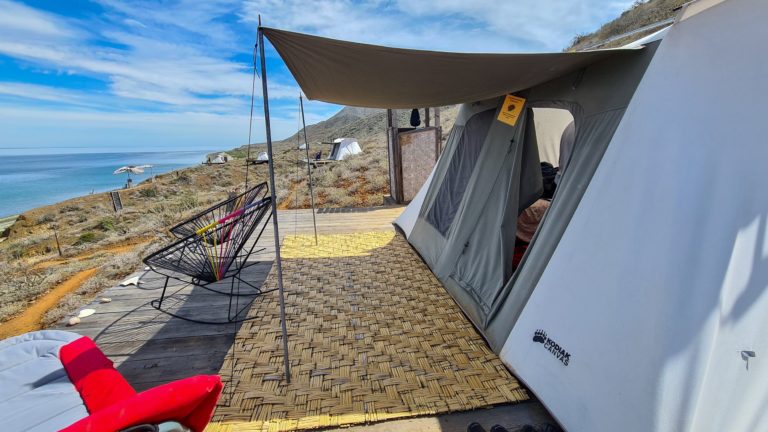Should You Touch a Grey Whale in Baja California Sur?
A complete guide to ethical Grey Whale Watching in Baja California Sur – The best place to see Grey Whales in Mexico!
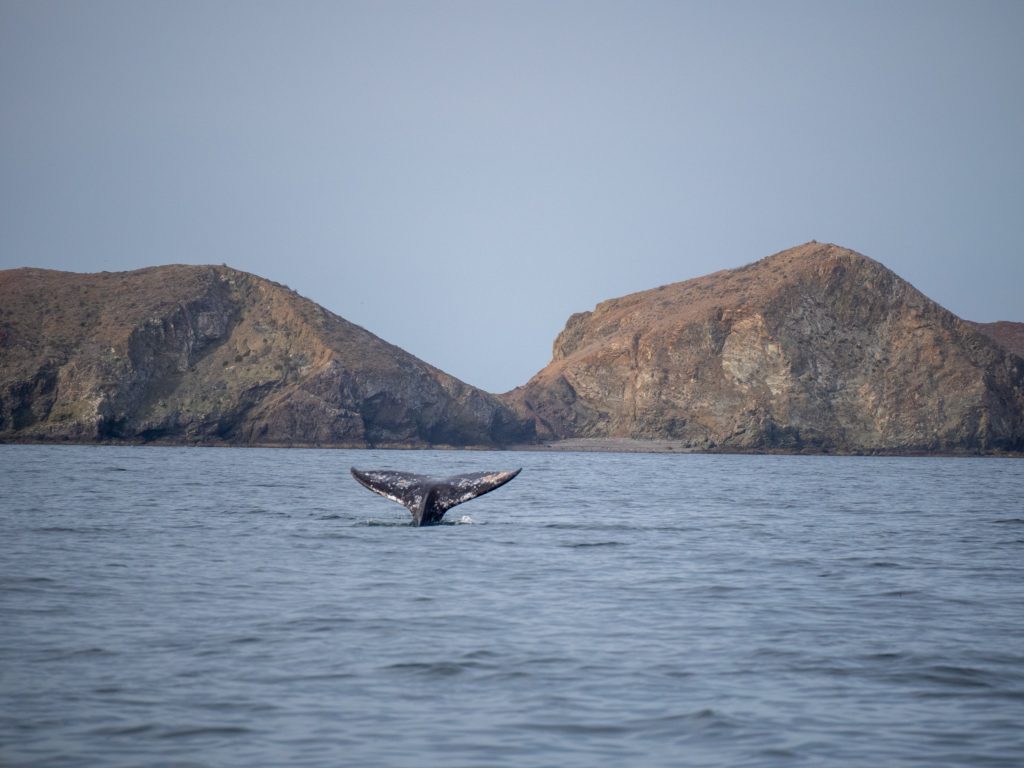
This post may contain affiliate links, which means we might earn a small commission on anything purchased through these links at no extra cost to you. Learn more on our disclaimer page.
Baja California Sur is a peninsula in Mexico and one of the best places in the world to see grey whales due to several protected lagoons along the Pacific Coast. These popular birthing and breeding grounds are world-renowned for hosting friendly whales who seek out human contact. Experiencing the friendly grey whales of Baja California Sur is without a doubt the best thing to do in Mexico. But, as with any animal encounter, it’s important to whale watch responsibly.
This article will delve into the history of whale watching in Magdalena Bay, address whether you can and should touch a grey whale in Baja California Sur and answer all your questions about visiting Mexico during grey whale season 2024.
Time needed: 2-4 days.
When to go: December-April for grey whale watching, but February-March for the highest numbers of whales.
Weather: Sunshine is common all year round, with temperatures of 16-23°C in (60-73°F) the winter and 21-32°C (69-89°F) in the summer. The bay can be windy and evenings in winter can be especially chilly.
Language: Spanish, but English is widely spoken too.
Currency: Mexican Peso.

About Grey Whales
Grey whales (or gray whales) go by many names. Their scientific name is eschrichtius robustus and they are also known as grey back whales, Pacific grey whales, Korean grey whales, or California grey whales. Grey whales are baleen whales, meaning they don’t have any teeth. Instead, they filter feed on the ocean floor. This is what gives them their dappled exterior as they pick up barnacles and other small parasites, which look like white blotches on their grey skin.
Grey whales have small dorsal fins and spiky bumps along their backs, which are called knuckles. We thought their knuckles made them look a bit like sea-dinosaurs. They only have one predator (besides humans) which is the orca.

Where can you see Grey Whales in Mexico?
There are three lagoons on the Pacific Coast of Baja California Sur (BCS) that grey whales frequent: Laguna Ojo de Liebre (Ojo de Liebre Lagoon), Laguna San Ignacio (San Ignacio Lagoon), and Bahía de Magdalena (Magdalena Bay). All three of these lagoons are amongst the best destinations in the world to see grey whales. They provide calm, warm waters which are perfect conditions for calving and mating, as well as being protected from predators who hunt in the open waters of the ocean.
Both Ojo de Liebre (formerly known as Scammon’s Lagoon) and San Ignacio lie in the Vizcaíno Biosphere Reserve, which is the largest wildlife refuge in Mexico and is listed as a UNESCO World Heritage Site. Ojo de Liebre is the furthest north, sitting approximately halfway between the tip of Baja California Sur and the American border. While San Ignacio sits between Ojo de Liebre and Magdalena Bay and stretches 16 miles (25km) into the desert.

San Ignacio is considered the best lagoon for grey whale encounters, although there’s no evidence to support that the whales there are friendlier. It’s possible that, because it’s the smallest lagoon, the whales are more densely concentrated and easier to find. Being further north, San Ignacio and Ojo de Liebre are quieter than Magdalena Bay and therefore receive fewer tourists. However they are also more remote and are difficult to get to without a car or transportation as part of a tour.
Magdalena Bay sits a 3 hour drive from Baja California Sur’s capital, La Paz, making it the most accessible lagoon. It is also therefore the most popular and the cheapest option for those hoping to see a grey whale. Magdalena Bay is protected by 2 islands: Isla Santa Margarita and Isla Magdalena and there are two port cities on the mainland that whale watching tours depart from: Puerto San Carlos and Puerto López Mateos.
Read next: The Thorough Guide to Magdalena Bay Whales’ Grey Whale Camp
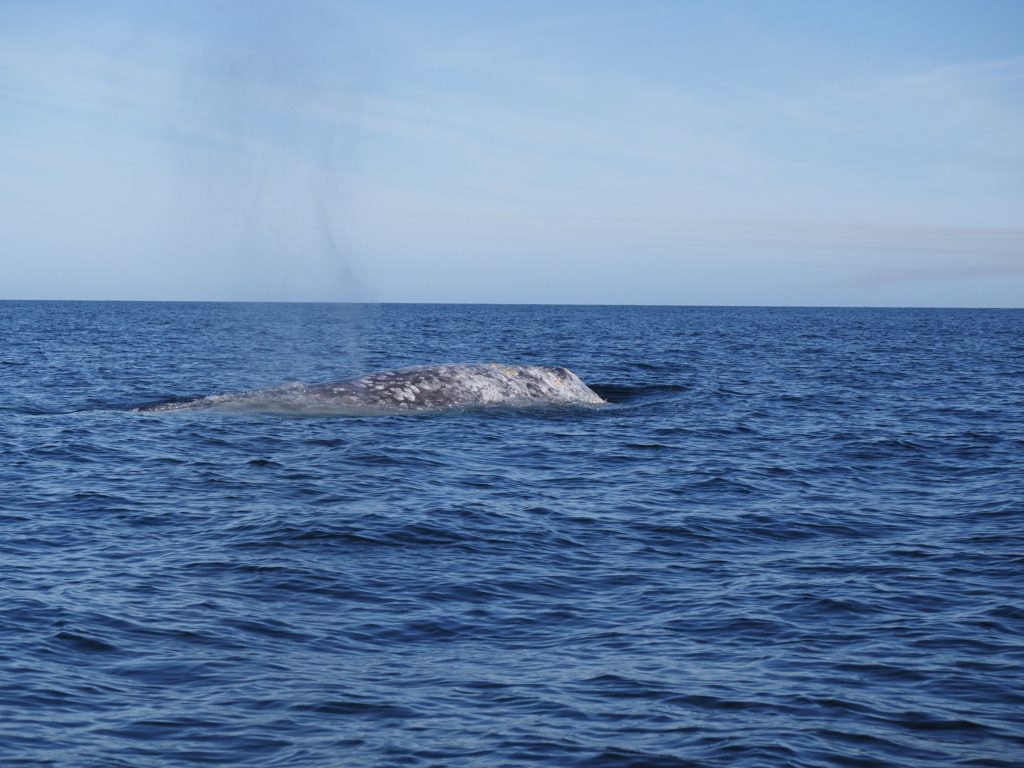
Interactive Map of Baja California Sur’s Grey Whale Lagoons
When can you see Grey Whales in Baja California Sur?
Grey whales come to Baja California Sur annually to mate. They migrate 10,000-14,000 miles (16,000-22,000 km) from the Arctic to the Pacific Coast of Mexico and back again each year. Their gestation period is 12 months so they breed and birth in the same lagoons they migrate to annually. Females only give birth to one calf at a time to ensure the calf gets the maximum attention it needs to survive.

Grey whales start to arrive around Baja California Sur from December and have left by April each year. But the best time to visit is in the peak of the grey whale watching season, from January-March. We recommend visiting during late February to early March as this is when there is the highest number of whales in the lagoons and you’ll be more likely to see mothers with their calves. Male grey whales tend to make their way back to the feeding grounds earlier than the females and calves, who are the last to leave the lagoons.
Grey whales tend to arrive into Ojo de Liebre first, as this is the first lagoon they reach. Naturally, as Magdalena Bay is the furthest south, they arrive there last and leave a little earlier than the more northern lagoons. So if you plan to visit Baja California Sur at the beginning or end of the season, Ojo de Liebre or San Ignacio might be a better option for you.

What makes Baja California Sur’s Grey Whales special?
You might have already heard, but Baja California Sur is the only place in the world where you can actually touch a grey whale. For some unknown reason, the whales here are really friendly and often approach boats, rubbing up against them and displaying curious behaviours like spy-hopping. It’s speculated that, as the inhabitants of the lagoons are made up of fishing families, the whales became used to the presence of fishermen and formed close bonds with them. It was not uncommon for females to introduce their newly-born calves to the fishermen and therefore those whales grew up to introduce their calves to the boats and so on.

Can you touch a Grey Whale in Baja California Sur?
In almost all scenarios, touching wild animals is an unethical experience and is detrimental to the animals’ wellbeing. But in Baja California Sur the whales seek out human interaction. It’s for this reason tourists visit BCS for the chance to touch, pet and kiss a grey whale. And, because the interaction is carried out on the whales’ terms and with their consent, it’s an exception to the rule.
Having said that, not all grey whales in Baja’s bays are interested in human interaction and it’s important that any contact is carried out at the instigation of the whale, not because the tour boat approaches or gets too close to a whale. It’s important to manage your expectations when visiting Baja’s lagoons and to choose a licensed company that will respect the whales.
Read next: Let’s Talk About Ethical Wildlife Tourism
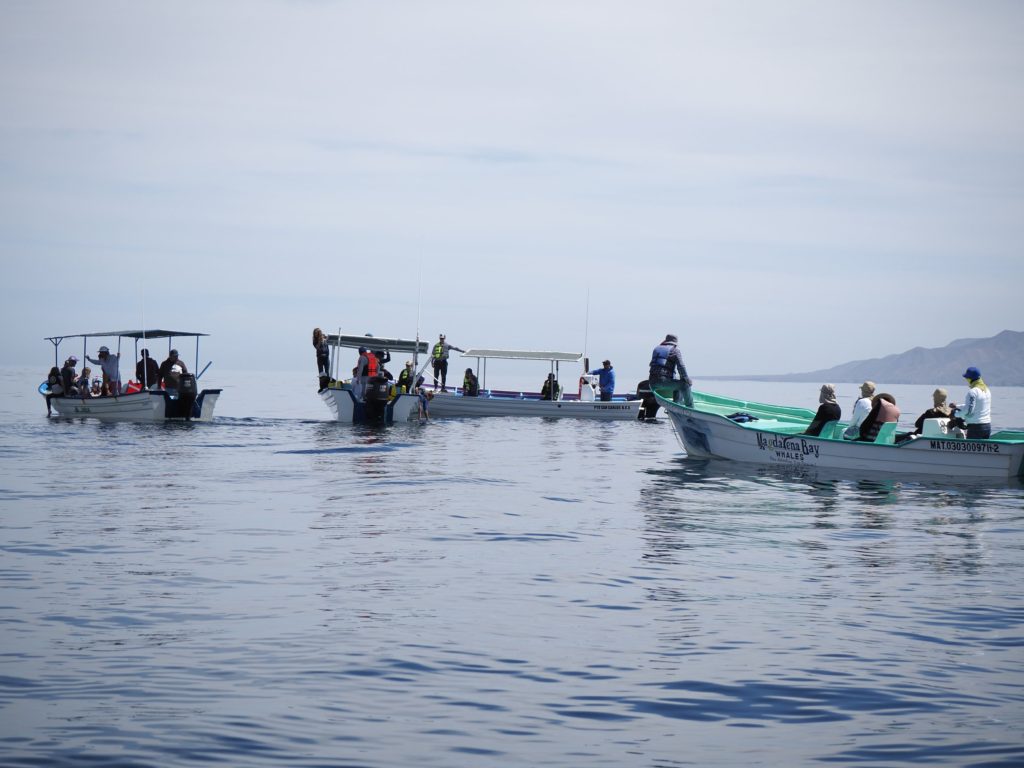
Is it ethical to touch Grey Whales in Mexico?
We’ve established that you CAN touch grey whales in BCS’s lagoons. But now we’d like to discuss whether you SHOULD. To answer this question it helps to understand the history of the grey whale.
The history of whale watching
The 19th century saw the start of whaling in Baja California Sur. The grey whale lagoons off BCS became popular whaling targets, with the first whaling expedition to Ojo de Liebre Lagoon occurring in 1857 and San Ignacio Lagoon in 1860. Both whaling expeditions were led by Charles Melville Scammon, an American whaler. Soon French, Dutch and Russian whaling ships were also operating in the lagoons, slaughtering hundreds of whales as they went. It’s the whaling trade that gave grey whales their nickname – devil fish – as mothers would fight viciously to save their harpooned calves, destroying boats in the process.
It’s estimated that between 1846 and 1874, approximately 8,000 grey whales were killed by American and European whalemen, with over half of these being killed in Magdalena Bay alone. Whaling in the lagoons contributed to the near extinction of grey whales. Thankfully, due to strict regulations and protections, the eastern North Pacific (North American) grey whale population has recovered and is now considered of ‘least concern’. It’s now believed there are around 28,000 grey whales globally. But unfortunately the western North Pacific (Asian) grey whale is still classed as ‘endangered’.
With the decrease in hunting and the increase in whale numbers, a new opportunity arose: whale watching. The first eco-camps in Baja California Sur’s lagoons were established in the 1970s and what followed was a new industry that gave visitors the chance to experience whales in their natural habitat.

What restrictions are in place?
Mexico is the only country in the world to provide protection for the habitat of the eastern population of grey whales. A marine refuge zone was established by Federal Decree in 1972 for whales in Ojo de Liebre Lagoon but it was deemed ineffective as it was clear to local residents that the bay was still being overfished. In 1988 Mexico’s President Miguel de la Madrid created a 2.5 million hectare (6.2 million acre) protected area called El Vizcaíno Biosphere Reserve – Latin America’s largest nature preserve – which encompasses Ojo de Liebre and San Ignacio’s lagoons. Restrictions include a limit on the number of boats in the lagoon and on activities (no swimming or chasing whales is allowed). No more than two boats can approach a whale at one time and a ranger stands on shore to monitor that these rules are adhered to.

Should you touch a grey whale?
Most literature online concurs that touching whales in Baja California Sur’s lagoons is not harmful to the animals and is ethical – so long as you travel with a licensed company. But there are still a few things we should bear in mind.
Touching any animal can transfer harmful bacteria to humans and vice versa. Touching a grey whale can transfer infectious diseases like brucellosis, which affects the reproductive and nervous systems of marine mammals, to humans and make them sick. Tuberculosis and leptospirosis are two other harmful diseases that can be transferred to humans and affect the lungs and other organs.
Human bacteria can also be transferred to whales and, while it may not harm them, it can be rubbed off and propagated to corals. These bacteria can then damage or kill the corals, which are already dealing with issues like climate change, declining water quality, overfishing, pollution and unsustainable coastal development.
It’s not just bacteria we need to be mindful of. Chemicals in products like sun cream can also be rubbed off onto marine flora, which can damage them and contribute to bleaching. When in or around the ocean, be sure to use a biodegradable, reef-safe sun cream that won’t harm the environment. You can find several great options here (US) or here (UK).
It’s also worth considering the impact being physically close to a whale can have. Human touch is not a natural behaviour for whales and as such their reaction can be unpredictable. Mothers particularly can be very aggressive if they think the safety of their calf is threatened. Being close enough to touch a whale can cause it stress and, at a weight of 27,000 kg (90,000 lbs), can cause you harm too. A recent study of humpback whales in Reunion Island found “agonistic behaviors in the presence of swimmers”, some of whom were injured during the experience. When whale watching, it’s generally a good idea to always keep a safe distance, whether on a boat or swimming.
Finally, touching a whale isn’t actually condoned by the Mexican government, it’s more of a loophole. If a boat is approached by a whale it has to stay still and touching isn’t mentioned in the law at all.
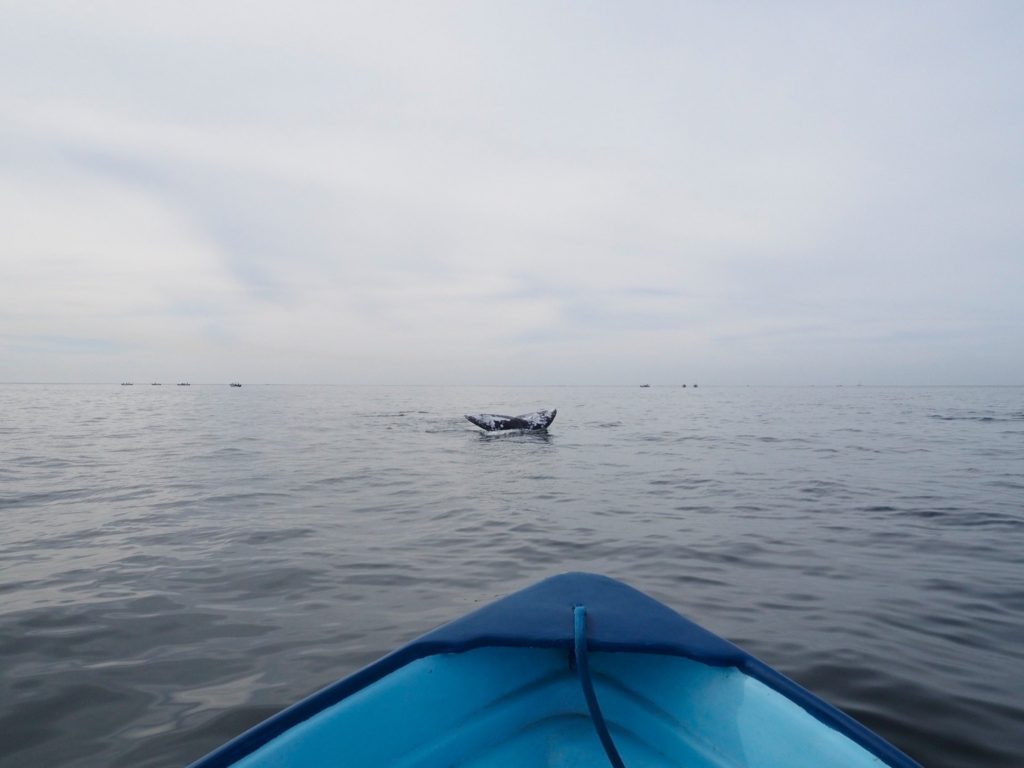
So should you touch a grey whale?
Basically, in any situation that includes wildlife tourism, you should always consider your impact. Superficially, it sounds like a dream to touch a grey whale. And, with a licensed company and a bit of luck, that dream can become a reality in Baja California Sur – a place where whales approach boats on their own terms, seeking human contact. If you are in a situation where you can touch a grey whale without negatively impacting it or the environment then there’s really no problem. Just be sure to analyse each situation individually and ensure you are confident with the impact (or lack of) of your actions.

How can you see Grey Whales in Baja California Sur?
Due to the restrictions in place to protect the grey whales, unless you’re lucky enough to see a whale from the shore, you can only see Baja’s grey whales up close as part of a tour. You can take a whale watching tour at any of the three lagoons, but we’d highly recommend choosing a camp. There is nothing in the world like waking up in the middle of nowhere, being able to see whales out in the lagoon as you unzip your tent and then getting on a boat for a day of close-up grey whale encounters.
We’d highly recommend Magdalena Bay Whales Glamping Camp on Isla Magdalena. Magdalena Bay Whales is a locally owned company with over 45 years experience whale watching in the lagoon. They really care for the protection and conservation of the whales and their eco-camp is paradise on earth.
Read next: The Thorough Guide to Magdalena Bay Grey Whale Camp
If you’re staying in Los Cabos, it’s quite a long way to go for a day trip. We’d recommend taking a 2 Day Grey Whale Watching Tour with Cabo Trek. An ecotourism company based in Cabo San Lucas, Cabo Trek are the first and only operator to obtain the recognition of Responsible Whale Watching Operator assigned by the World Cetacean Alliance. They also run responsible and once-in-a-lifetime whale watching trips in Los Cabos where you can get up close to humpback whales, who often put on incredible acrobatic display in the bay.
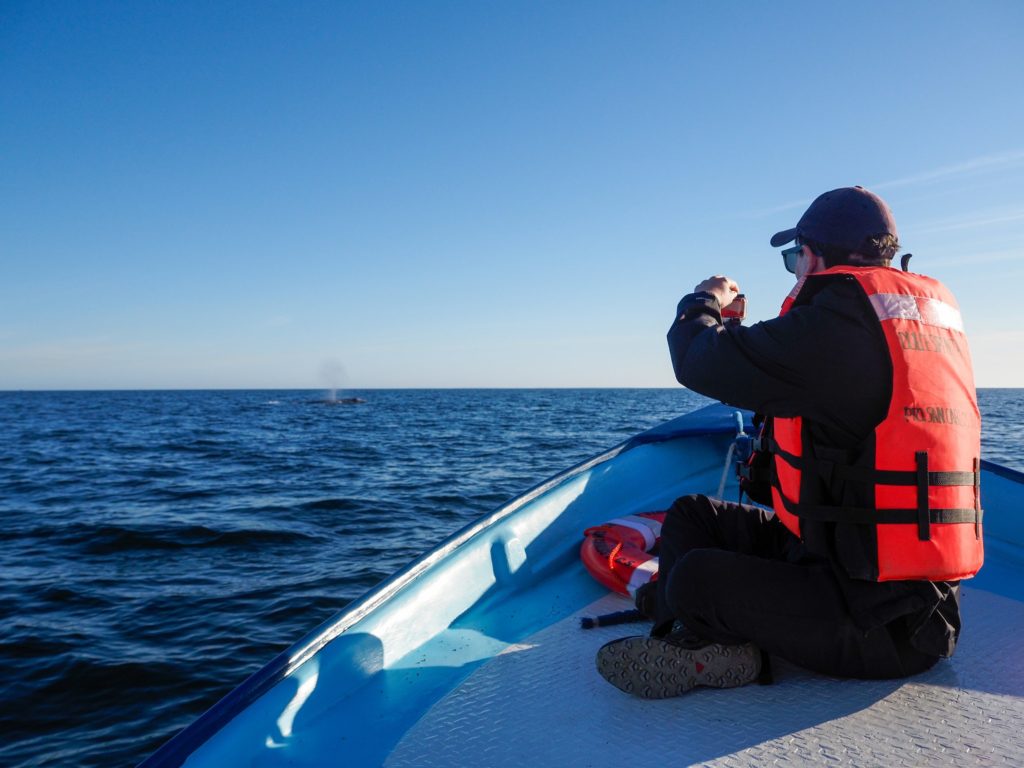
Tips for choosing an Ethical Tour Company
- Make sure you book with a responsible company who care for the whales’ wellbeing and will respect their boundaries.
- Read reviews on TripAdvisor and Google to look for indications other customers were happy with the treatment of the whales.
- Read the company’s website to see if they mention the importance of respecting the whales and following the regulations. Get a feel for their values and morals.
- Don’t go whale watching with the intention to touch a grey whale. You have to remember that seeing any wildlife in its natural habitat is a privilege. You are not entitled to an encounter with it, are lucky to see one and even luckier if one does come close seeking contact.
- We learned that, while most operators advertise grey whale tours as ‘touch the friendly grey whales of Baja’, actually only 30% of visitors are lucky enough to have this experience. If a company claims otherwise you have to ask yourself what lengths they’ll go to for you touch a whale and if it’s ethical.
- Consider your impact on the whale with every encounter.
Read next: Let’s Talk About Ethical Wildlife Tourism

Read next:
Everything you need to know about Blue Whale Watching in Loreto
Everything you need to know about Humpback Whale Watching in Los Cabos
Everything you need to know about Swimming with Whale Sharks in La Paz
Everything you need to know about Snorkelling with Sea Lions in La Paz






